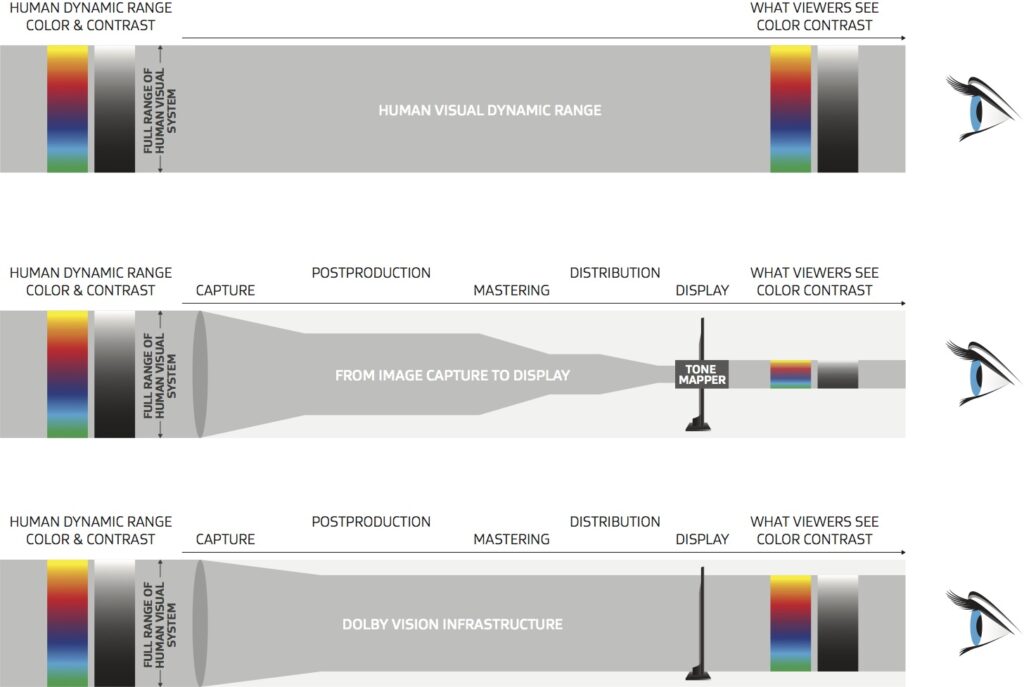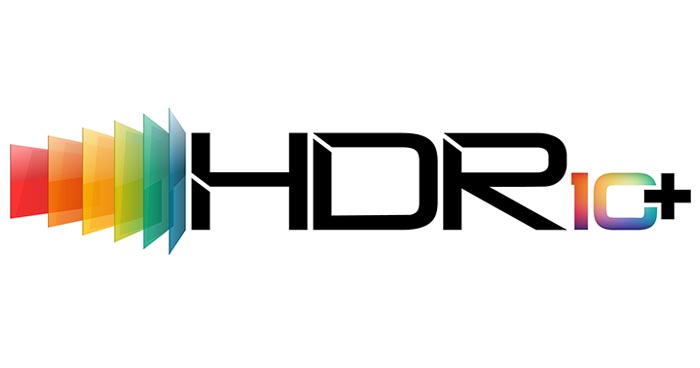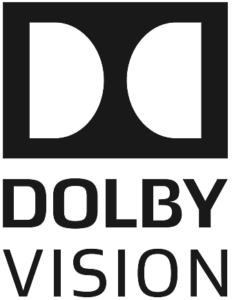High Dynamic Range – What is HDR?
When buying a TV, you often come across terms and abbreviations that you can’t quite put your finger on. This also includes HDR or High Dynamic Range, which is mainly used in connection with a significantly better picture quality. But what exactly does HDR mean and why do I need this technology? We have summarized the most important facts for you here.
What is HDR? – Definition of HDR and SDR
The abbreviation HDR stands for High Dynamic Range and the technology is designed to make colors and contrasts more vivid, resulting in even more realistic images on your TV. Before HDR, there was only SDR, a format that you still encounter on regular TV programming and older movies and series. SDR simply means Standard Dynamic Range.
But where exactly are the differences and why is HDR so much better? SDR displays a color depth of 8 bits and the equivalent of 16.77 million possible colors. HDR has a color depth of 10 bits and over 1 billion possible colors, which means that color transitions, such as a sunset, can be displayed much more smoothly.

However, HDR is not only about the increased color depth, but also about the brightness and the resulting higher contrast. You can simplify the whole process by superimposing several images that have been exposed differently. In this way, a significantly higher contrast is achieved and details that were not visible before now become much more perceptible. The focus is always on what the human eye can see, because the goal of HDR technology is to display content as close as possible to reality – and thus close to what our eyes perceive.
The human eye can perceive a wide spectrum of colors and brightness levels. With film recordings that are processed in various ways afterwards, not much of the variety that was actually recorded reaches the viewer in the end. Only HDR technology and corresponding TV sets make it possible to offer consumers more realistic content.
HDR specifications
Not all devices are HDR-capable according to the specifications of the Ultra HD Alliance. Certain specifications have to be met for HDR to work to its full extent. If not all specifications are given, only a limited HDR support is available.
- For LCD TVs: At least a peak brightness of 1,000 nits and a black level of 0.05 nits or less – or a contrast ratio of at least 20,000:1.
- For OLED TVs: At least a peak brightness of 540 nits and a black level of 0.0005-nits or less – or at least 1,080,000:1 contrast ratio (for OLED)
- 4K Ultra HD resolution: 3840×2160
- 10-bit color support for at least 90% DCI-P3 color space (125% sRGB)
- HDMI version 2.0
Dolby Vision, HDR10+ and HLG – Different methods at a glance
Currently, HDR10+ and Dolby Vision dominate in terms of HDR. Both methods have existed since 2015, when the Ultra HD Blu-ray came onto the market as a storage medium. This is because only the possibility to store significantly more data on a data carrier made it possible to support movies with a high contrast range and larger color space.
| Color depth | Metadata | Manufacturer | Supported by | |
| HLG | – | – | all common manufacturers | YouTube |
| HDR10 | 10 bit | static | all common manufacturers | Netflix, iTunes, Amazon Prime, Blu-ray, gaming consoles |
| HDR10+ | 10 bit | dynamic | Samsung, Panasonic, Hisense | Amazon Video, Ultra HD Blu-ray |
| Dolby Vision | 12 bit | dynamic | LG, Sony, Panasonic, Hisense | Ultra HD Blu-ray, Amazon Prime Video, Netflix, iTunes |
HLG
HLG stands for Hybrid Log Gamma and is an HDR broadcast format developed by the British BBC in collaboration with Japan’s NHK. HLG makes it possible to provide a video stream for both SDR and HDR devices. The main issue here is capacity, since broadcasters have only a limited transmission rate available and, thanks to HLG, no metadata needs to be processed. Providing one channel for both SDR and HDR content would not only drive up broadcasters’ costs, the available bandwidth would also be insufficient.
HLG is found on most modern televisions these days and is used primarily for normal television programming.
HDR10 and HRD10+
The HDR format HDR10+ can mainly be found in Samsung devices, as the South Korean company continues to fully support this format. Accordingly, HDR10+ is a royalty-free dynamic metadata platform that is supported by 20th Century Fox, among others. While HDR10 only optimizes the brightest scene of a whole movie, the HDR10+ dynamic format analyzes each scene individually and optimizes it accordingly. This results in a higher-contrast and more color-intensive image.

With the even more current HDR10+ Adaptive, the image optimization is also adapted to the brightness of the surroundings. Thus, the brightness of each scene is analyzed and compared with the brightness of the surroundings via a sensor and optimized accordingly.

Dolby Vision
Dolby Vision is a direct competitor of HDR10+, but is more widely used both by streaming services and in the movie industry itself. Therefore, it is also supported by most TV manufacturers to guarantee optimal image processing for most content. The brightness and thus the contrast of the content is also optimized here, as well as the colors, which are much more vivid as a result. Compared to HDR10+, Dolby Vision is subject to a fee for the manufacturers, but the corresponding devices are also Dolby-certified.
The next generation of Dolby Vision is called Dolby Vision IQ and behaves similarly to HDR10+ Adaptive. In that sense, it is not a new format, but an extension of the already existing one, which is additionally oriented to the ambient brightness. This additionally adjusts the brightness of the image content to the brightness of the surroundings.

OLED TVs in particular benefit from Dolby Vision because they do not achieve as high a peak brightness as comparable LED TVs. Because Dolby Vision dynamically adjusts every scene, OLED TVs, which offer infinite contrast and perfect black, can play to their strengths even better.
Furthermore, Dolby Vision can also be used as an even better HDR format when gaming on the Xbox Series X, as far as Dolby Vision Gaming is supported by the TV. So far, this is only possible with LG’s OLEDs C1 and G1. This also optimizes games scene by scene accordingly to make them look even more realistic.
Gaming in HDR
HDR is not necessary to play on the TV. Especially not if you only pick up the controller from time to time and want to plunge into a quiet adventure. However, things look different when you really want to play extensively and on the highest level.
HDR initially delivers more lifelike pictures, which really pulls you directly into the action. Corresponding TVs with HDR deliver more vivid colors and a much higher contrast, so you can see enemies much better even in the darkest corners.
Dolby Vision Gaming promises the highest HDR enjoyment even when gaming, and that even in 4K@120Hz. However, this is currently only the case with the Xbox Series X and only in combination with a Dolby Vision Gaming-enabled TV. Additional features like a VRR and an Auto Low Latency Mode are also important for Dolby Vision Gaming to work.
Games also have to support Dolby Vision Gaming and the list of available games is still manageable. Thus, titles like F1 2021, Flight Simulator, Ori and the Will of the Wisps, and The Division 2 are capable of making extensive use of the HDR format. Halo Infinite will be the first game designed specifically for Dolby Vision Gaming.
Dolby Vision Gaming is still in its infancy, however, as the technology has yet to reach its full potential. Purchasing a new TV specifically for Dolby Vision Gaming is therefore not advisable, especially if your current TV is only a year or two old.
HDR advantages
HDR mainly plays a role when you watch a lot of current movies and series. If you only watch the normal TV program, it will not make a big difference whether you have an HDR-capable TV or not. However, if you are a movie and series enthusiast, you will want to achieve the best possible quality in your home theater. Only if a TV supports an HDR format can you experience compatible movies and series the way the director intended.
Where to find HDR content?

Finally, it is also important to see where HDR content is available at all. Here, linear TV is largely omitted, since only a few broadcasters produce in UHD, which is ultimately broadcast in lower quality, though. Therefore, you should take a closer look at streaming providers like Netflix & Co. But there are differences here as well, because not every service supports every format.
Netflix offers movies and series in HDR10 as well as Dolby Vision, whereby the streaming service mainly relies on the latter format for in-house productions. The situation is reversed for Amazon Prime Video, where HDR10+ is the preferred format. Apple TV completely relies on Dolby Vision, which is why users should buy a corresponding TV.
Don’t forget the fine print: Not every subscription to the corresponding streaming services supports both HDR and UHD content. In order to enjoy the full scope, you have to sign up for a premium subscription in most cases.
In addition, there is of course the Ultra HD Blu-Ray, which has brought everything to life. There is also a wide selection here, but the Blu-rays are usually much more expensive than a corresponding subscription to a streaming service.
HDR TVs: The best models
Sony A90J
The Sony A90J is not only inherently an excellent TV for watching movies and series, but also one of the best HDR TVs on the market.
It “only” offers Dolby Vision, but it scores with its very natural image processing that makes content look even more realistic. The OLED panel with all its benefits is the cherry on top, making the TV an excellent choice for all movie fans.
LG G1 OLED Evo
The design model LG G1 OLED Evo, supports “only” Dolby Vision IQ, but it offers the best basis for experiencing Dolby Vision gaming on the Xbox Series X. Not only are the gaming features of the G1 outstanding, the model is one of few that can support native Dolby Vision gaming.
Thus, Xbox Series X gamers can not only use the OLED panel with all its advantages, but also the dynamic HDR format Dolby Vision, which is also based on the ambient brightness thanks to IQ extension.
Hisense U7G
The considerably cheaper Hisense U7G cannot keep up with the expensive competition in many respects, but it can in terms of price-performance ratio. In addition, the inexpensive TV features Dolby Vision and HDR10+, which makes a significant difference.
The U7G can also be used excellently for gaming, even though Dolby Vision gaming is not an option here.
Frequently asked questions about HDR
What is HDR?
HDR stands for High Dynamic Range and is a picture technology that optimizes colors, brightness and contrast so that even more realistic pictures are created on the TV.
What is the difference between SDR and HDR?
SDR only uses a color depth of 8 bits, whereas HDR uses a color depth of 10 bits and can thus display over 1 billion colors. Thus, especially color transitions like a sunset are displayed much more smoothly.
Is HDR the same as 4K UHD?
The abbreviations 4K UHD and HDR are probably the most frequently encountered when buying a TV, but they are two different things. While both technologies are designed to improve picture quality, they do so in different ways.
4K, or UHD, refers only to the resolution of the image. While a few years ago Full HD TVs were considered the standard with a resolution of 1920 x 1080 pixels, 4K TVs are now taking over the market with a resolution of 3840 x 2160. Because 4K TVs can display four times as many pixels, images are much sharper and more detailed. UHD or Ultra HD are different terms, but refer to the same thing as 4K.
HDR, as described above, is a technology that significantly improves and optimizes color reproduction as well as brightness and contrast. This allows for more vivid colors, deeper blacks, and purer whites.








